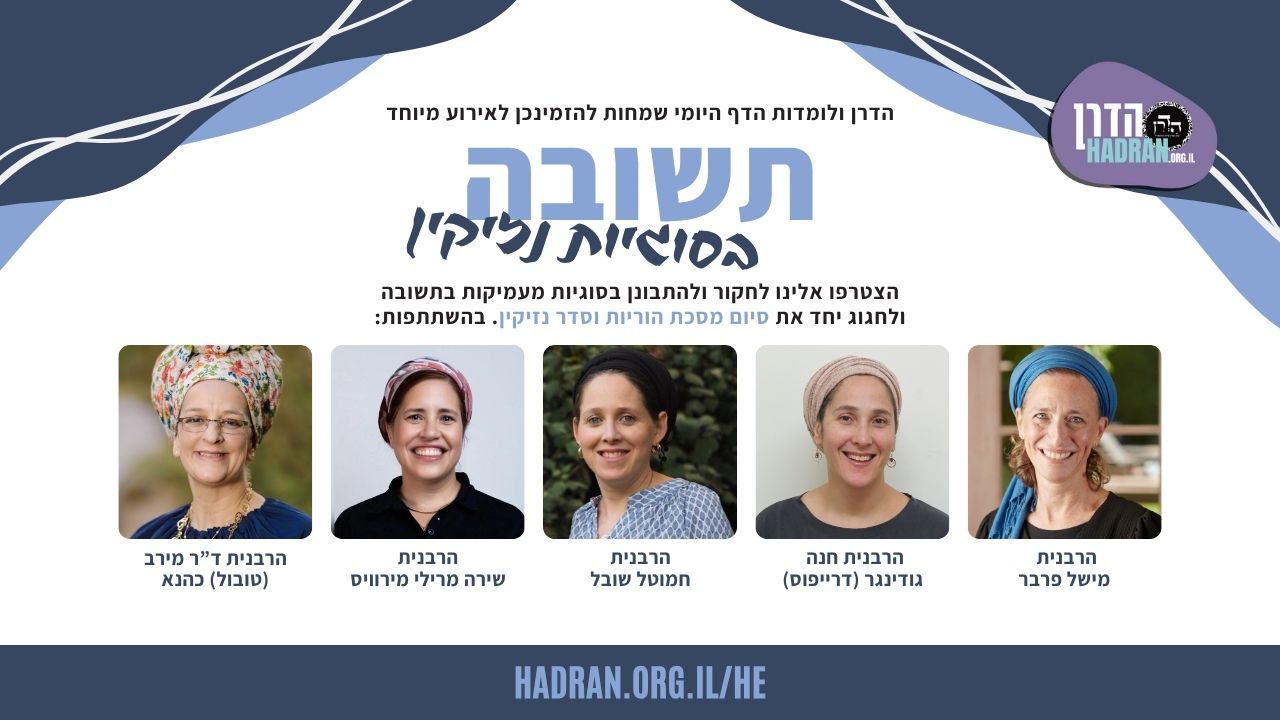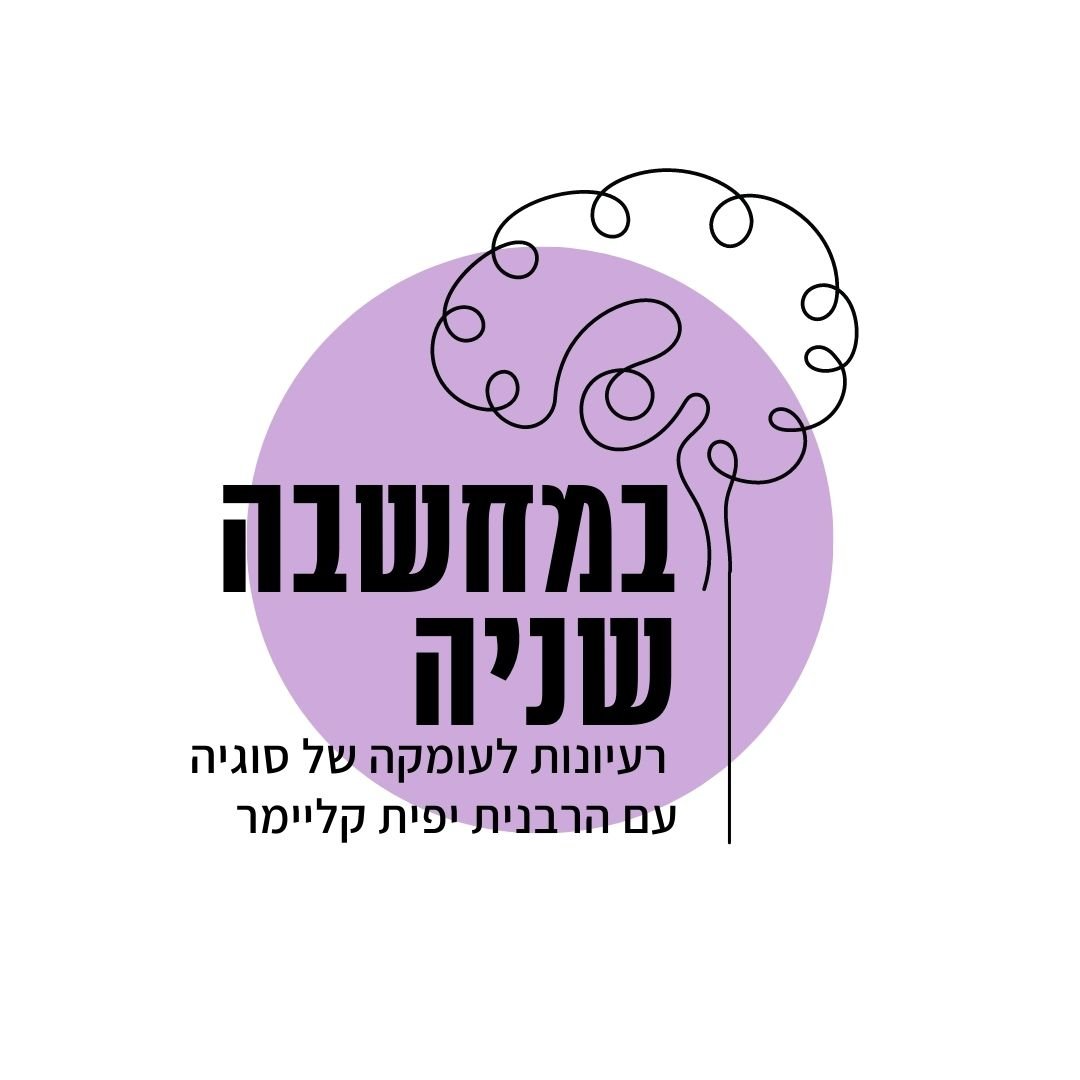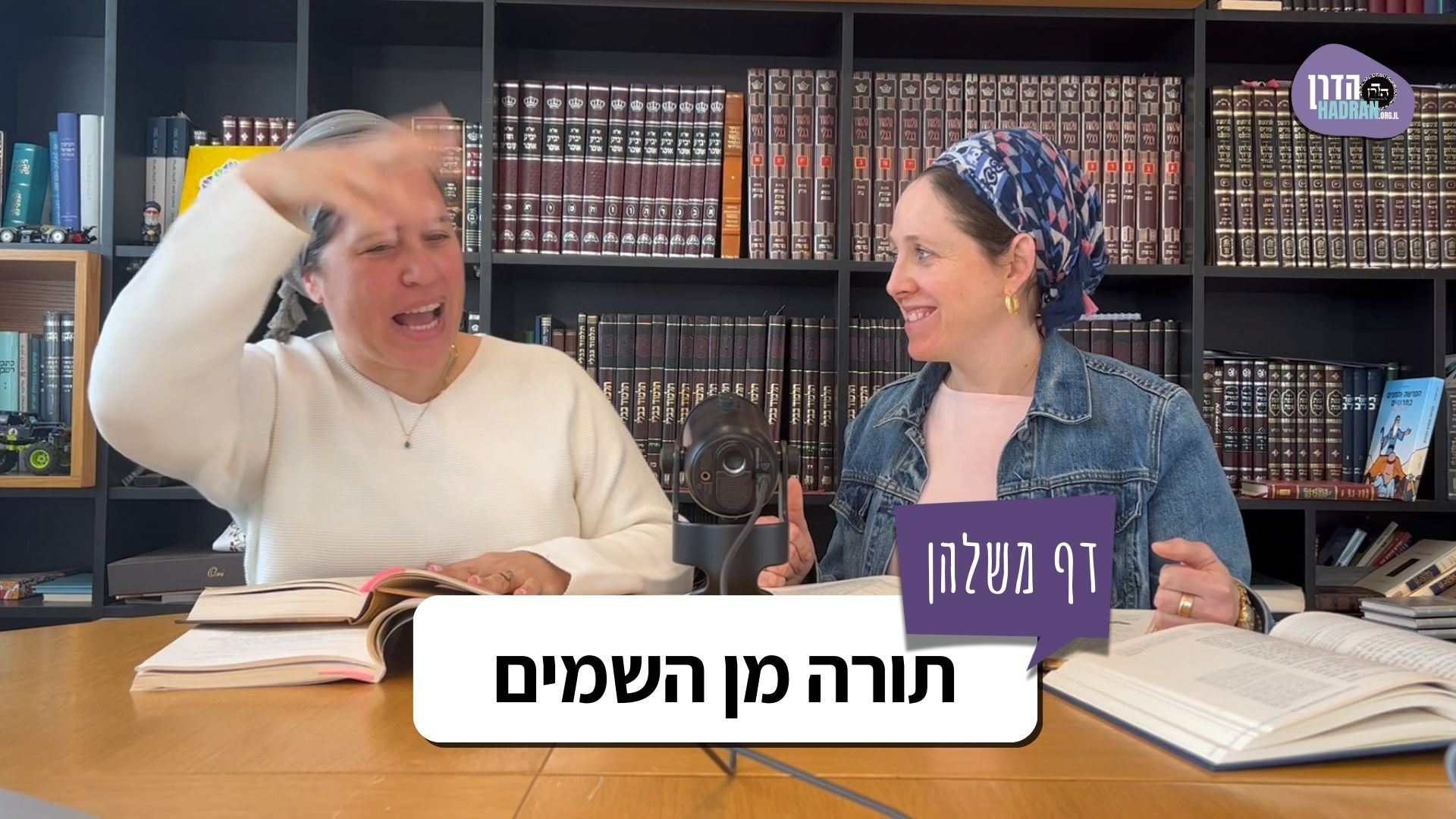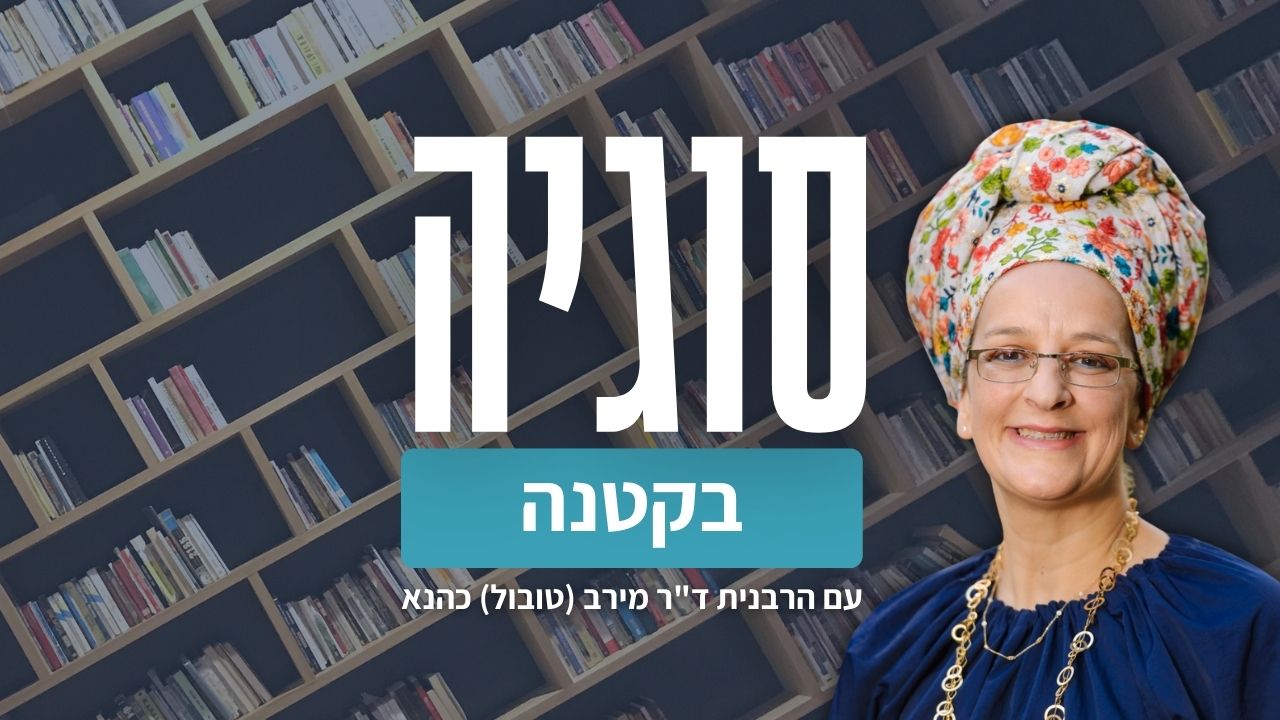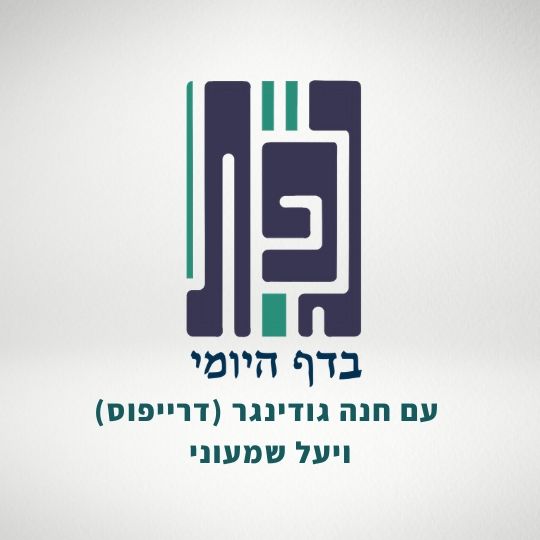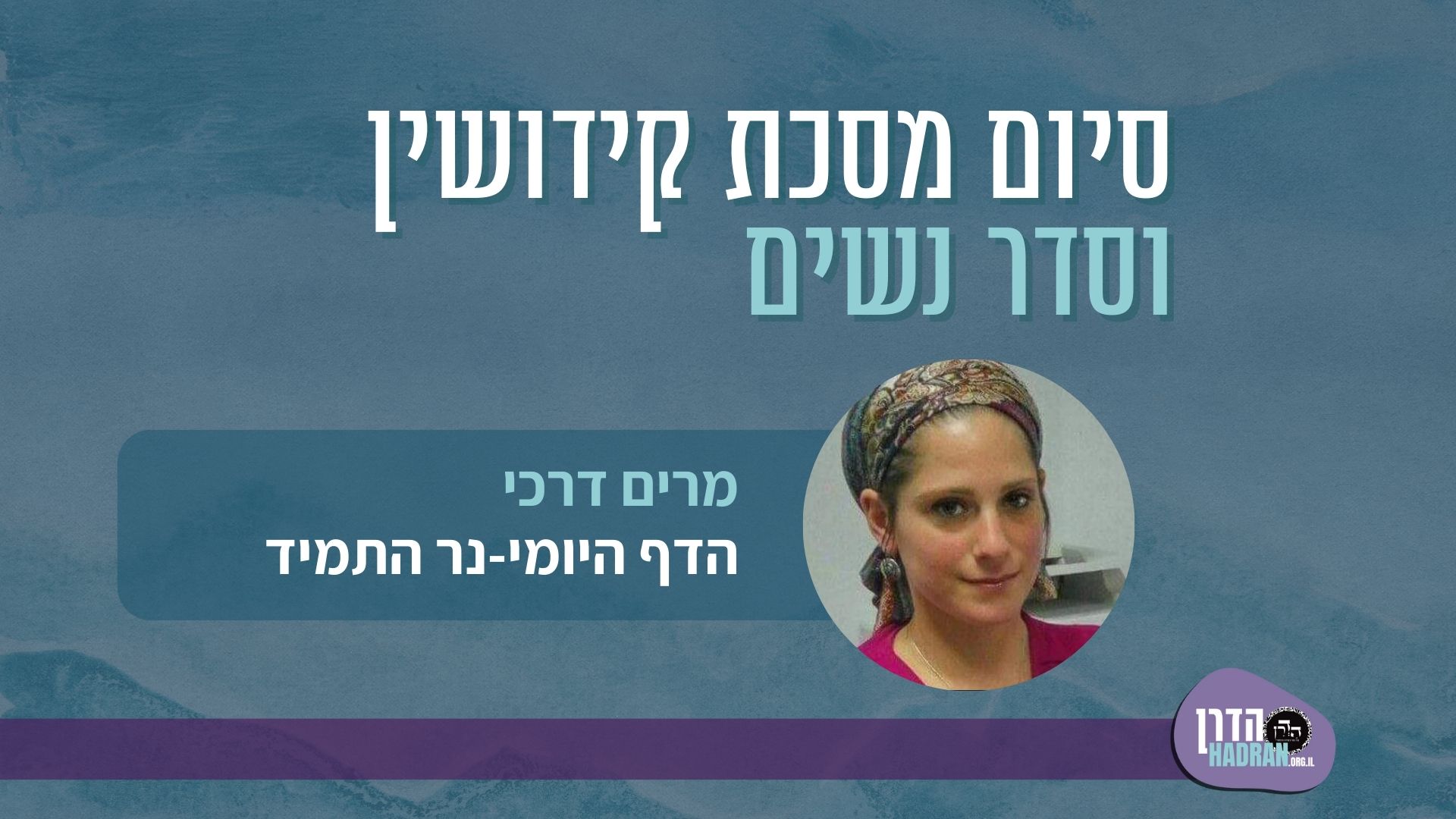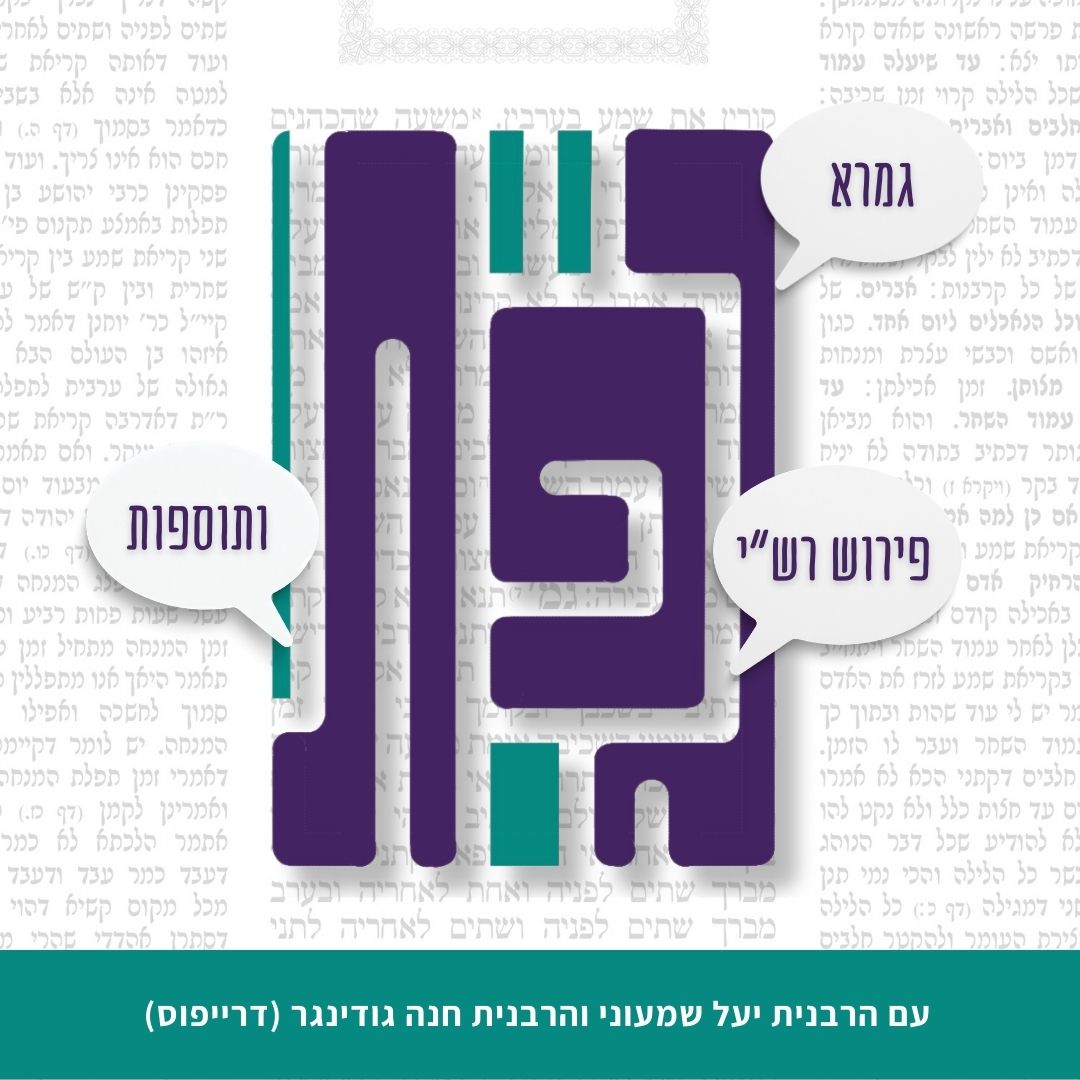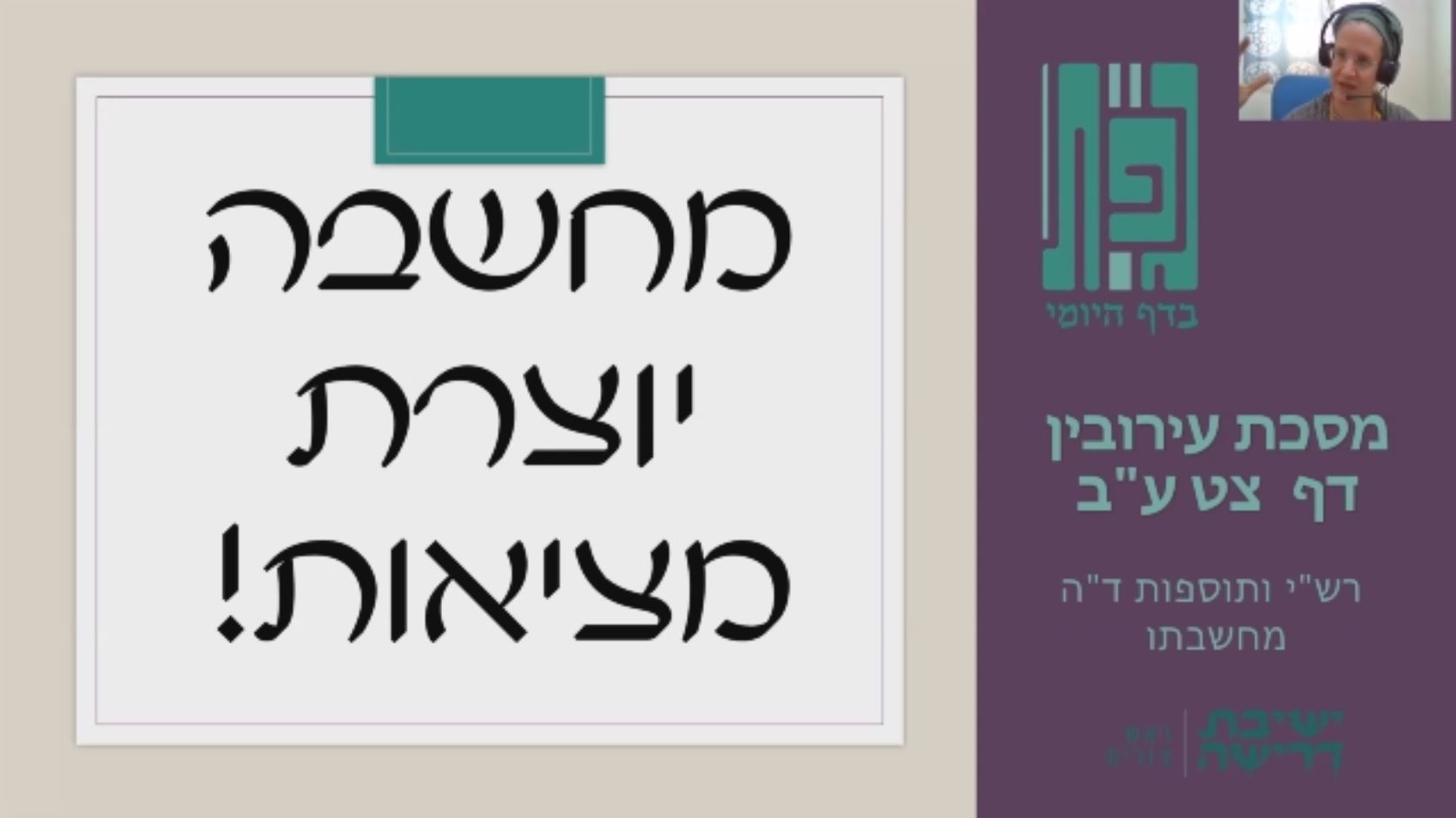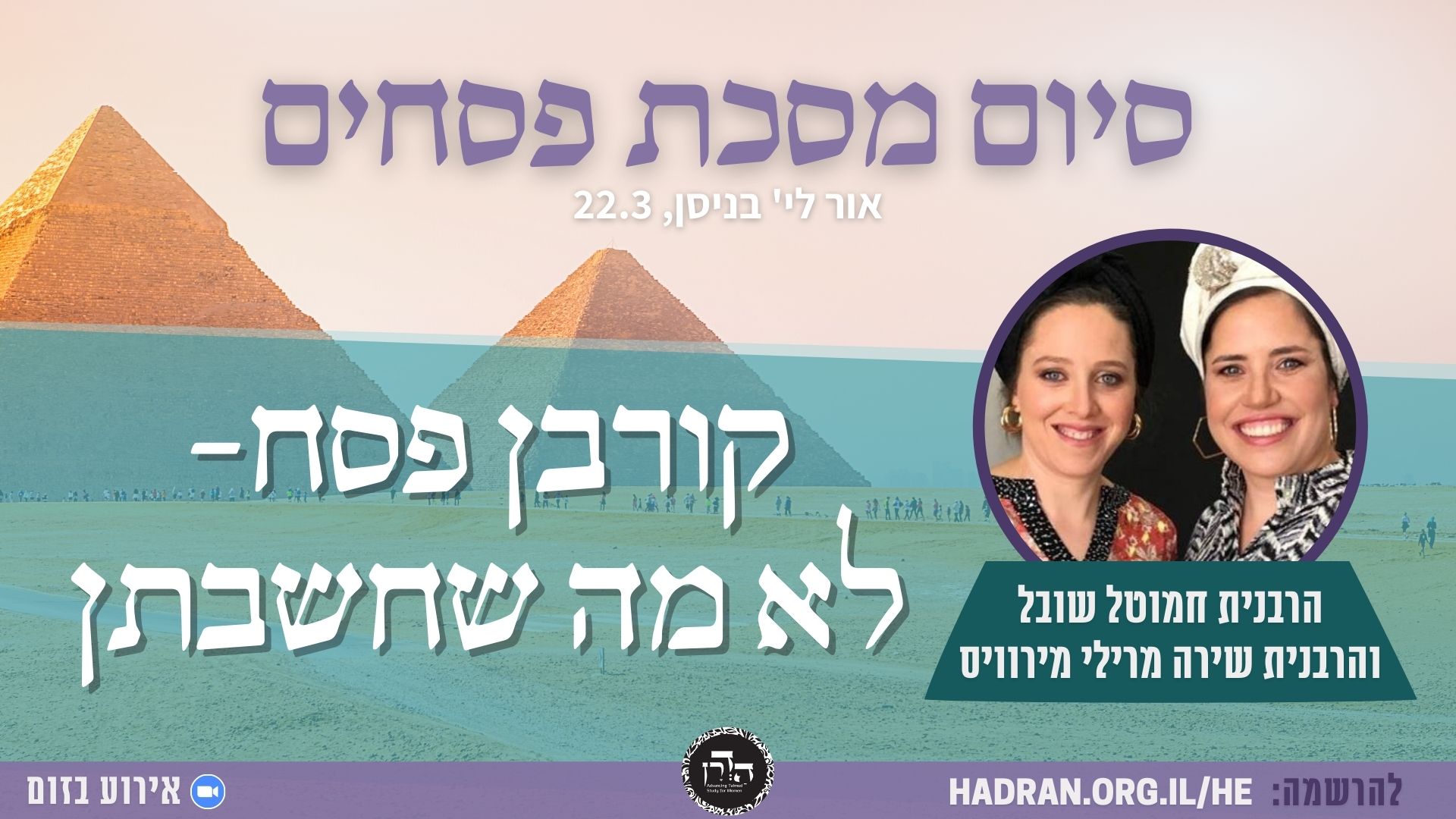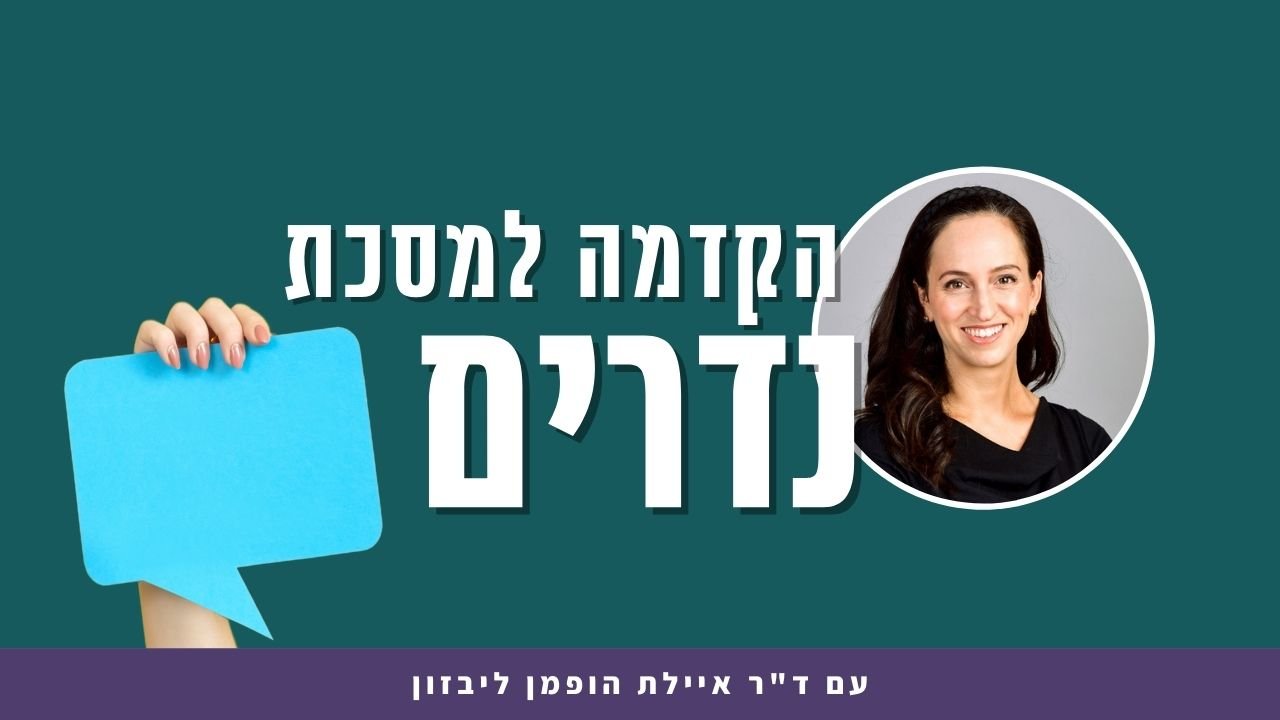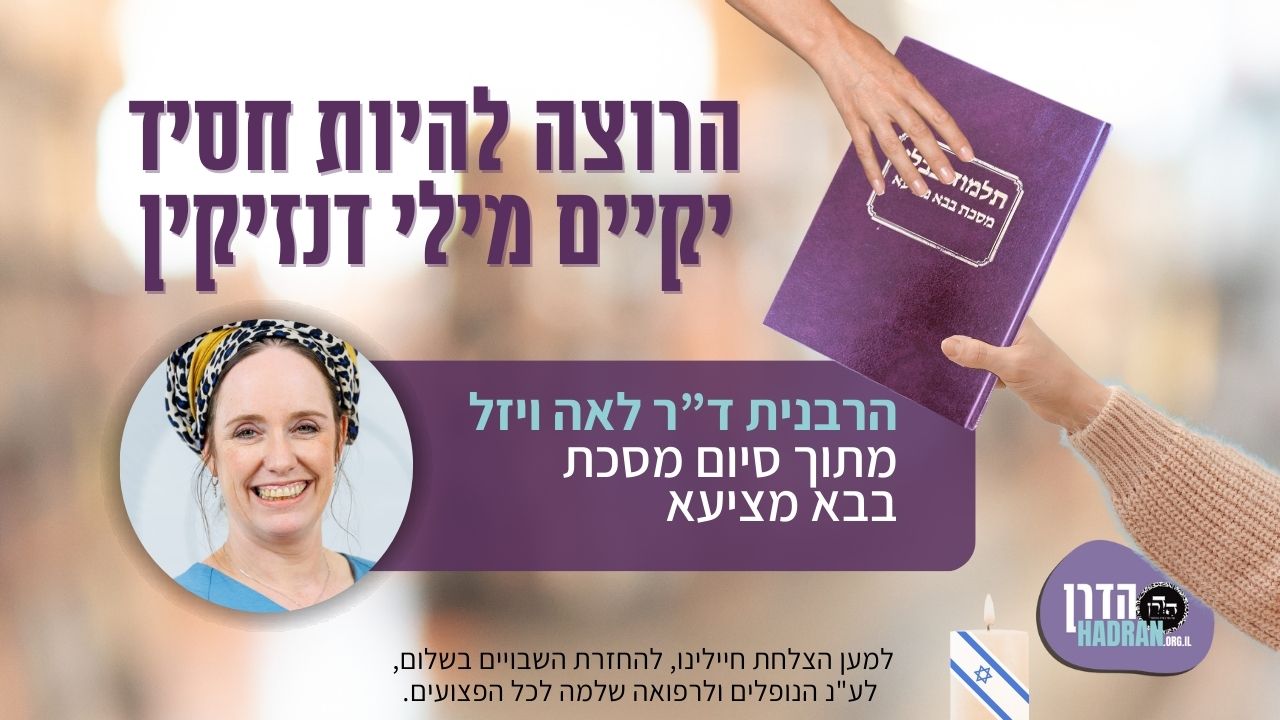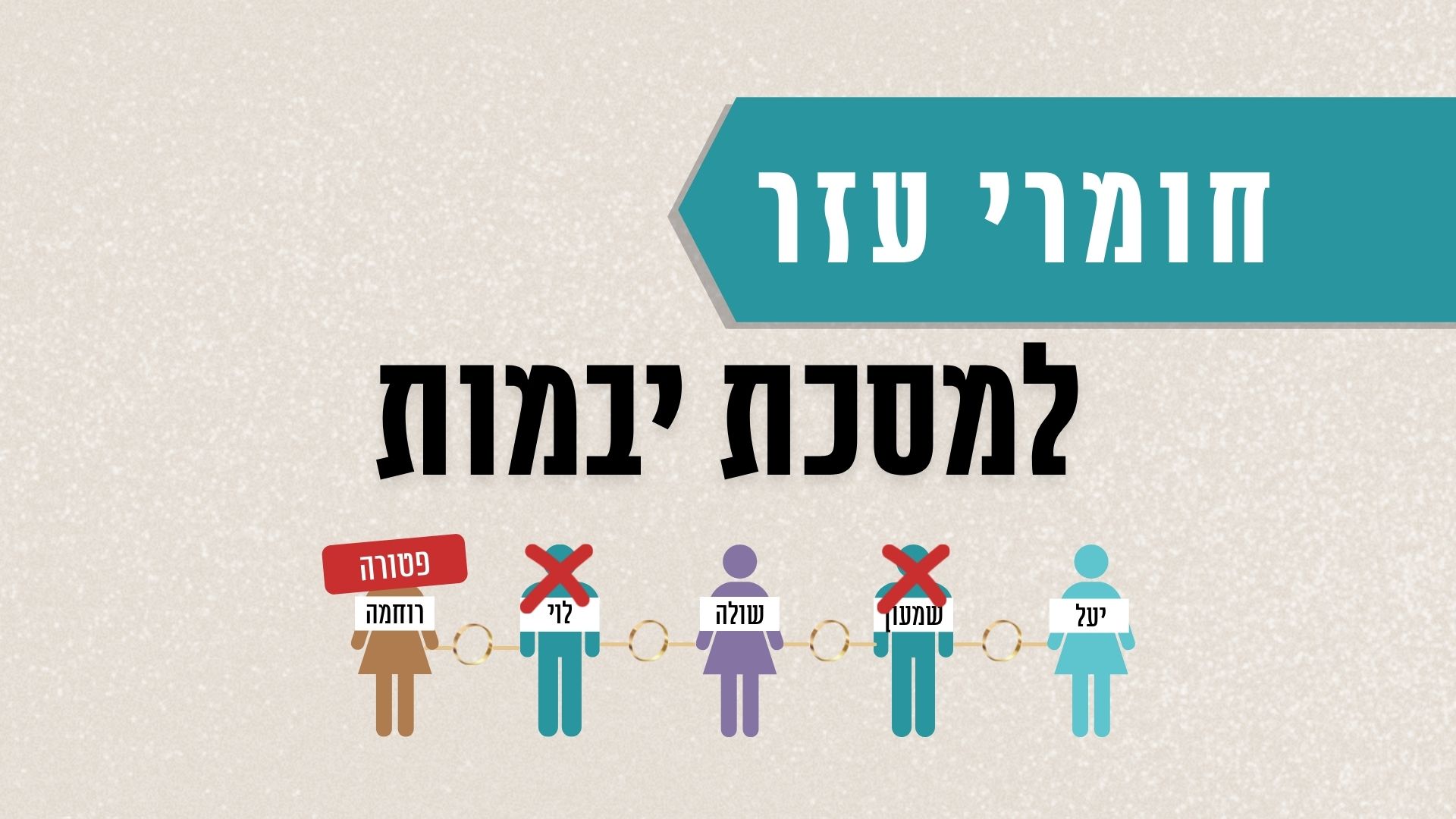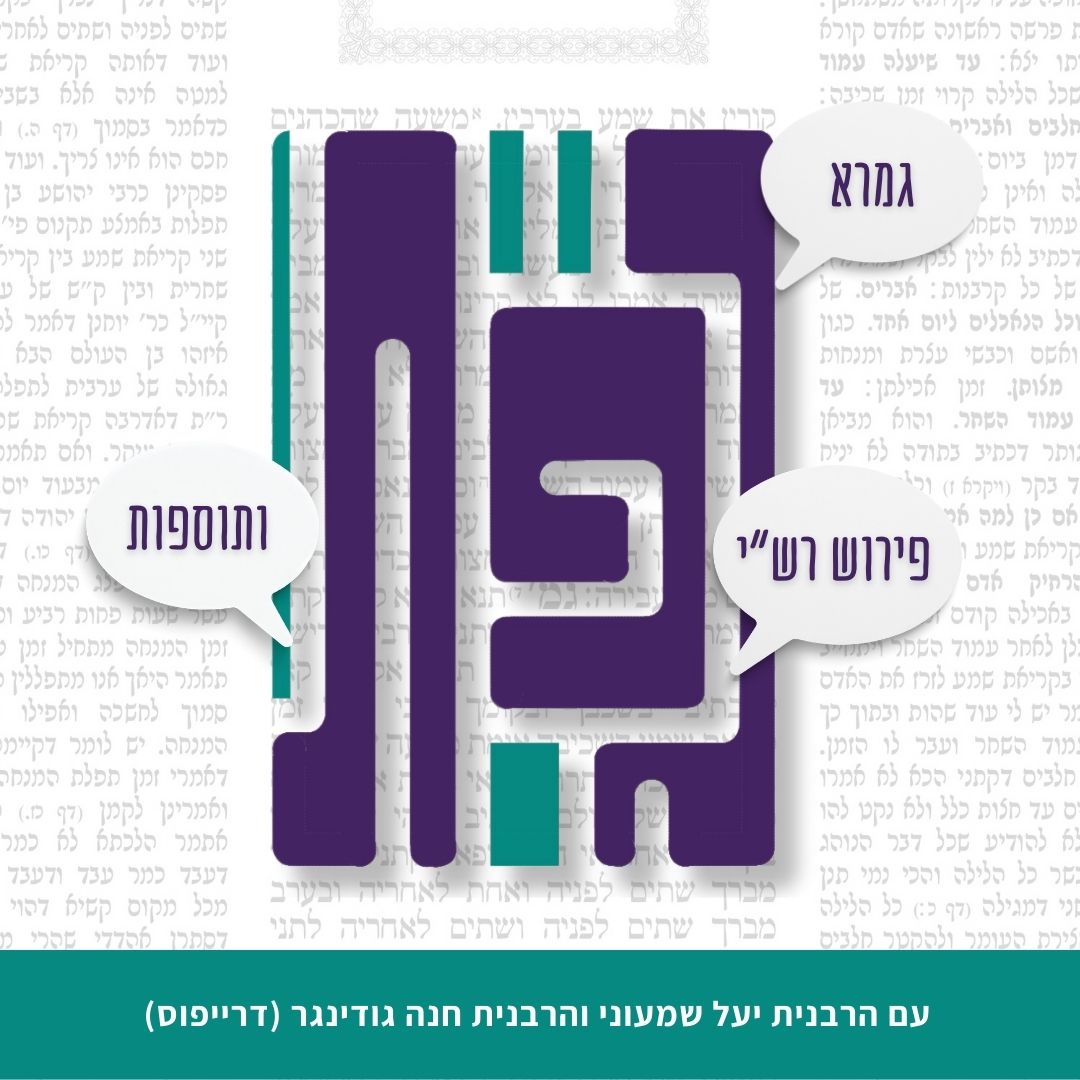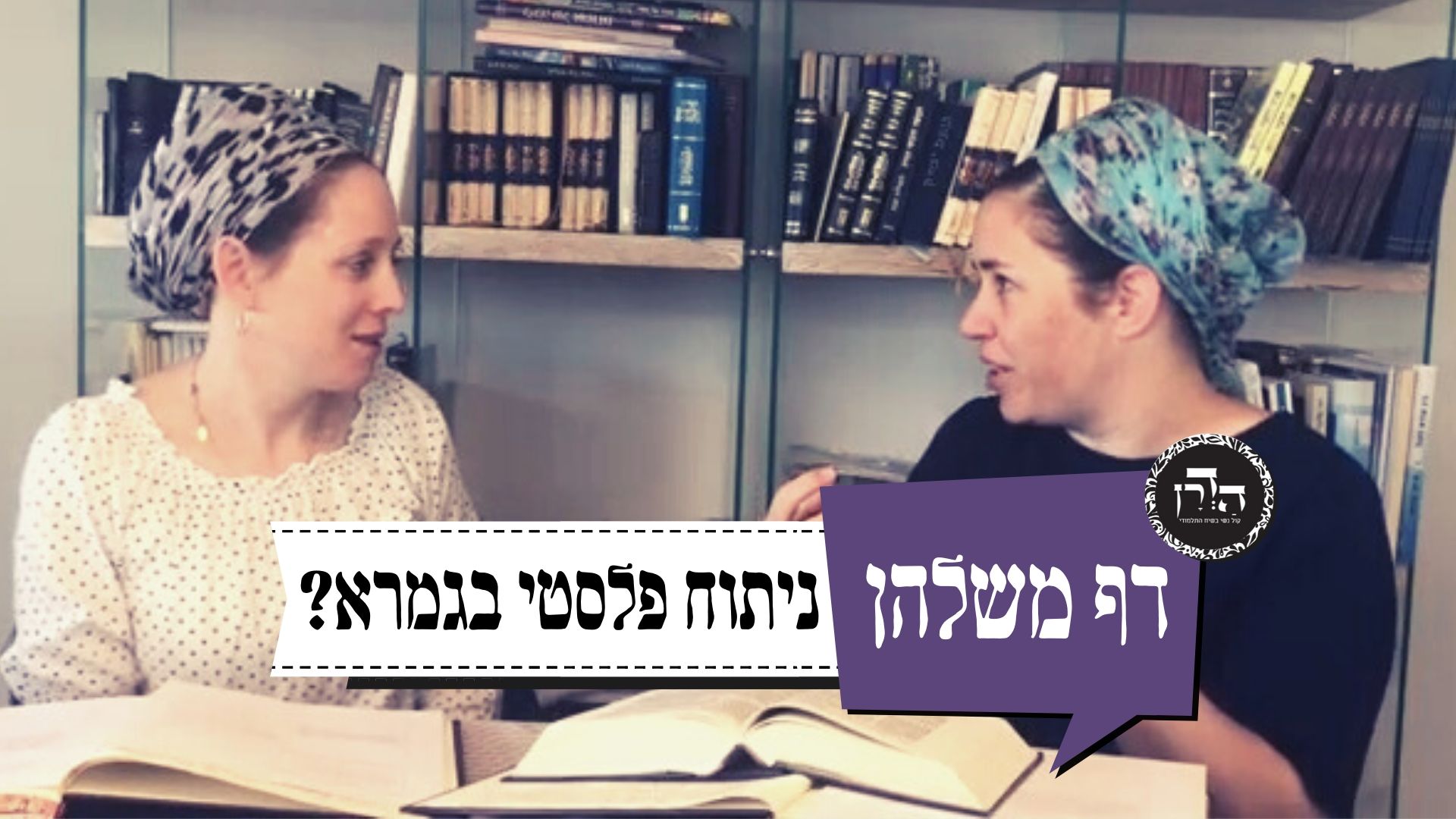מי נאמן או אינו נאמן להעיד על כך שהמום נפל בו בעצמו ולא הוטל בכוונה על ידי מישהו כדי להתירו באכילה?
הלימוד השבוע מוקדש ע”י אודרי מנדרו לע”נ יחזקאל בן רחל ואברהם.
הלימוד השבוע מוקדש ע”י קרוליין בולג לע”נ פנחס בן מנשה פייזר.
רוצה להקדיש שיעור?

כלים
הלימוד השבוע מוקדש ע”י אודרי מנדרו לע”נ יחזקאל בן רחל ואברהם.
הלימוד השבוע מוקדש ע”י קרוליין בולג לע”נ פנחס בן מנשה פייזר.
כלים
העמקה
רוצה להבין מה באמת קורה מתחת לפני השטח של הסוגיה?
שיעורים, פודקאסטים והרחבות של מיטב המורות שלנו יפתחו לך עוד זוויות וכיווני חשיבה.
חדשה בלימוד הגמרא?
זה הדף הראשון שלך? איזו התרגשות עצומה! יש לנו בדיוק את התכנים והכלים שיעזרו לך לעשות את הצעדים הראשונים ללמידה בקצב וברמה שלך, כך תוכלי להרגיש בנוח גם בתוך הסוגיות המורכבות ומאתגרות.
פסיפס הלומדות שלנו
גלי את קהילת הלומדות שלנו, מגוון נשים, רקעים וסיפורים. כולן חלק מתנועה ומסע מרגש ועוצמתי.
בכורות לה
טִימֵּא טְהָרוֹת וָמֵת — לֹא קָנְסוּ בְּנוֹ אַחֲרָיו. מַאי טַעְמָא? הֶיזֵּק שֶׁאֵינוֹ נִיכָּר לָא שְׁמֵיהּ הֶיזֵּק, קְנָסָא דְּרַבָּנַן — לְדִידֵיהּ קְנַסוּ רַבָּנַן, לִבְרֵיהּ לָא קְנַסוּ רַבָּנַן.
that if one rendered impure the ritually pure items of another and died before paying, the Sages did not penalize his son after his death and require him to pay for the damage. What is the reason for this? The reason is that damage that is not evident, i.e., which does not involve any visible change, is not considered damage by Torah law. There is a penalty imposed by rabbinic law, as the injured party suffered a loss, but the Sages penalized only him; the Sages did not penalize his son.
מַתְנִי׳ מַעֲשֶׂה בְּזָכָר שֶׁל רְחֵלִים זָקֵן, וּשְׂעָרוֹ מְדוּלְדָּל, וְרָאָהוּ קַסְטוֹר אֶחָד וְאָמַר: מָה טִיבוֹ שֶׁל זֶה? אָמְרוּ לוֹ: בְּכוֹר הוּא, וְאֵינוֹ נִשְׁחָט אֶלָּא אִם כֵּן הָיָה בּוֹ מוּם. נָטַל (פיגום) [פִּיגְיוֹם] וְצָרַם אׇזְנוֹ, וּבָא מַעֲשֶׂה לִפְנֵי חֲכָמִים וְהִתִּירוּ, וְאַחַר שֶׁהִתִּירוּ הָלַךְ וְצֵירֵם בְּאׇזְנֵי בְכוֹרוֹת אֲחֵרִים וְאָסְרוּ.
MISHNA: There was an incident involving an old ram whose hair was long and dangling, because it was a firstborn offering. And one Roman quaestor [kastor] saw it and said to its owner: What is the status [tivo] of this animal that you allowed it to grow old and you did not slaughter it? They said to him: It is a firstborn offering, and therefore it may be slaughtered only if it has a blemish. The quaestor took a dagger [pigom] and slit its ear. And the incident came before the Sages for a ruling, and they deemed its slaughter permitted. And after the Sages deemed its slaughter permitted, the quaestor went and slit the ears of other firstborn offerings, but in these cases the Sages deemed their slaughter prohibited, despite the fact that they were now blemished.
פַּעַם אַחַת הָיוּ תִּינוֹקוֹת מְשַׂחֲקִין בַּשָּׂדֶה, וְקָשְׁרוּ זַנְבֵי טְלָאִים זֶה בָּזֶה, וְנִפְסְקָה זְנָבוֹ שֶׁל אֶחָד מֵהֶם, וַהֲרֵי הוּא בְּכוֹר, וּבָא מַעֲשֶׂה לִפְנֵי חֲכָמִים וְהִתִּירוּ. רָאוּ שֶׁהִתִּירוּ, הָלְכוּ וְקָשְׁרוּ זַנְבוֹת בְּכוֹרוֹת אֲחֵרִים, וְאָסְרוּ. זֶה הַכְּלָל: כֹּל שֶׁהוּא לְדַעְתּוֹ — אָסוּר, שֶׁלֹּא לְדַעְתּוֹ — מוּתָּר.
One time children were playing in the field and they tied the tails of lambs to each other, and the tail of one of them was severed, and it was a firstborn offering. And the incident came before the Sages for a ruling and they deemed its slaughter permitted. The people who saw that they deemed its slaughter permitted went and tied the tails of other firstborn offerings, and the Sages deemed their slaughter prohibited. This is the principle: With regard to any blemish that is caused intentionally, the animal’s slaughter is prohibited; if the blemish is caused unintentionally, the animal’s slaughter is permitted.
גְּמָ׳ פַּעַם אַחֶרֶת הָיָה כּוּ׳. וּצְרִיכָא, דְּאִי אַשְׁמְעִינַן גּוֹי — דְּלָא אָתֵי לְמִיסְרַךְ, אֲבָל קָטָן דְּאָתֵי לְמִיסְרַךְ — אֵימָא לָא.
GEMARA: The mishna mentions that one time children were involved in a case in which they unintentionally blemished a firstborn offering whose subsequent slaughter the Sages deemed permitted. The Gemara notes: And although the first clause of the mishna mentions a similar occurrence, the incident involving the children is necessary. As, had the tanna taught us only the incident involving the gentile, it might have been thought that the Sages permitted the slaughter of the firstborn offering only there, as it is not a problem if the gentile will acquire the habit of causing blemishes, because that prohibition does not apply to gentiles. But with regard to a Jewish minor, it is a concern that he is likely to acquire the habit of causing blemishes in firstborn offerings, and therefore one might say that even the first, unintentional time should not be permitted.
וְאִי אַשְׁמוֹעִינַן קָטָן, מִשּׁוּם דְּלָא אָתֵי לְאִיחַלּוֹפֵי בְּגָדוֹל, אֲבָל גּוֹי דְּאָתֵי לְאִיחַלּוֹפֵי בְּגָדוֹל — אֵימָא לָא. צְרִיכָא.
And had the tanna taught us only the incident involving a minor, it might have been thought that the Sages deemed the firstborn offering permitted only there, since there is no concern that people will come to confuse a minor with an adult. People would not erroneously conclude that it is permitted to cause a blemish on a firstborn offering intentionally merely due to an incident involving a minor. But in the case of a gentile adult, where this is a concern that people would come to confuse him with a Jewish adult, one might say that even the first, unintentional time should not be permitted. It is therefore necessary for the mishna to teach both cases.
אָמַר רַב חִסְדָּא אָמַר רַב קַטִּינָא: לֹא שָׁנוּ אֶלָּא דַּאֲמַרוּ לֵיהּ ״אֶלָּא אִם כֵּן הָיָה בּוֹ מוּם״, אֲבָל אִם אֲמַרוּ לֵיהּ ״אִם נַעֲשָׂה בּוֹ מוּם״ — כְּמַאן דַּאֲמַרוּ לֵיהּ ״זִיל עֲבֵיד בֵּיהּ מוּמָא״ דָּמֵי.
§ The Gemara analyzes the incident involving the Roman quaestor. Rav Ḥisda says that Rav Ketina says: They taught that the firstborn offering is permitted only in a case where the bystanders said to the quaestor: A firstborn offering may not be slaughtered unless it has a blemish, as this is referring to a blemish that develops naturally. But if they said to him that a firstborn offering may be slaughtered only if a blemish was caused to form upon it, which indicates human intervention, it is considered as though they explicitly told him: Go and cause a blemish on it, in which case the animal is prohibited.
אָמַר רָבָא: מִכְּדֵי מִמֵּילָא הוּא, מָה לִי ״הָיָה״, מָה לִי ״נַעֲשָׂה״? אֶלָּא ״נַעֲשָׂה״ נָמֵי מִמֵּילָא הוּא, וְלָא שְׁנָא.
The Gemara cites a dissenting opinion. Rava said: Now consider, both expressions in fact indicate that the blemish occurred by itself, as both statements are in the passive. Accordingly, what difference is it to me whether the bystanders used the expression: If it had a blemish, or the expression: A blemish was caused in it? Rather, the expression: Was caused, also indicates that it occurred by itself, and there is no difference between the expressions. In both instances the firstborn offering would be permitted.
זֶה הַכְּלָל: כֹּל שֶׁהוּא לְדַעַת — אָסוּר. לְאֵיתוֹיֵי מַאי? לְאֵיתוֹיֵי גְּרָמָא.
The mishna teaches that this is the principle: In the case of any blemish that is caused with his intent, the animal’s slaughter is prohibited. The Gemara explains: What does this principle serve to add? It serves to add an indirect action, i.e., a blemish caused in this manner is also considered an intentional act and the animal may not be slaughtered on its account.
שֶׁלֹּא לְדַעַת — לְאֵיתוֹיֵי מֵסִיחַ לְפִי תוּמּוֹ.
The Gemara further inquires: What is added by the phrase in the second part of the principle: If the blemish was caused without his intent, the animal’s slaughter is permitted? This serves to add an instance where a gentile did not inquire about the nature of the firstborn offering, but rather discovered it from one who speaks offhandedly. Although the gentile intentionally caused a blemish in the animal, since the Jew did not intentionally prompt him to cause it, the animal is permitted.
מַתְנִי׳ הָיָה בְּכוֹר רֹדְפוֹ, בְּעָטוֹ, וְעָשָׂה בּוֹ מוּם — הֲרֵי זֶה שׁוֹחֲטִין עָלָיו.
MISHNA: If one’s firstborn offering was pursuing him, and he kicked the animal and caused a blemish in it, he may slaughter the animal on account of that blemish.
גְּמָ׳ אָמַר רַב פָּפָּא: לֹא שָׁנוּ אֶלָּא שֶׁבְּעָטוֹ בִּשְׁעַת רְדִיפָה, אֲבָל לְאַחַר רְדִיפָה — לָא. פְּשִׁיטָא!
GEMARA: Rav Pappa says: They taught that the firstborn offering may be slaughtered only in an instance where he kicked it at the time of its pursuit. But if the individual kicked the animal after its pursuit, it may not be slaughtered, as he intended to cause a blemish in order to render it permitted to be slaughtered. The Gemara raises a difficulty: It is obvious that it is not permitted to slaughter the animal in such a case.
מַהוּ דְּתֵימָא: צַעְרֵיהּ הוּא דְּמִדְּכַר, קָא מַשְׁמַע לַן.
The Gemara explains: Rav Pappa’s statement is necessary, lest you say that it is in fact permitted to slaughter the firstborn offering since he kicked it after its pursuit only out of anger, as he recalls his distress caused by its pursuit of him, and not in order to render the animal permitted to be slaughtered. Rav Pappa therefore teaches us that it is assumed that he kicked the animal with the express intention of causing a blemish in it, not merely out of anger, and therefore it may not be slaughtered.
אִיכָּא דְּאָמְרִי, אָמַר רַב פָּפָּא: לָא תֵּימָא בִּשְׁעַת רְדִיפָה — אִין, אֲבָל שֶׁלֹּא בִּשְׁעַת רְדִיפָה — לָא, אֶלָּא אֲפִילּוּ לְאַחַר רְדִיפָה נָמֵי. מַאי טַעְמָא? צַעֲרֵיהּ [הוּא] דְּמִדְּכַר.
There are those who say the opposite version of this discussion. Rav Pappa says: Do not say that if the individual kicked the firstborn offering at the time of the pursuit, then yes, it is permitted to slaughter it, but if he kicked it not at the time of the pursuit, it is not permitted to slaughter it. Rather, even if he kicked it after its pursuit of him, it is also permitted. What is the reason? It is assumed that he kicked it after the pursuit not with the intention of causing a blemish, but because he recalls his distress caused by its pursuit of him.
אָמַר רַב יְהוּדָה: מוּתָּר לְהַטִּיל מוּם בִּבְכוֹר קוֹדֶם שֶׁיָּצָא לַאֲוִיר הָעוֹלָם. אָמַר רָבָא: גַּדְיָא בְּאוּדְנֵיהּ, אִימְּרָא בְּשִׂפְוָותֵיהּ. אִיכָּא דְּאָמְרִי: אִימְּרָא נָמֵי בְּאוּדְנֵיהּ, אֵימוֹר דֶּרֶךְ צְדָעָיו נְפַק.
§ Rav Yehuda says: It is permitted to cause a blemish in a firstborn fetus before it emerges into the air of the world, as it obtains its sacred status only when it is born. Applying this ruling, Rava said: In the case of a kid, it is practical to cause a blemish on its ear. Since a kid’s ears are long they emerge from the birth canal prior to the head. With regard to a lamb, whose ears are short and do not appear before the head, it is practical to cause a blemish only on its lip. There are those who say that there is a different version of this statement: In the case of a lamb as well, it is practical to cause a blemish on its ear, as one can say that it emerges from the birth canal through its temples, in which case its ears are visible first.
אָמַר רָבָא: אָכֵל וְלָא מִיחֲזֵי, פָּעֵי וּמִיחֲזֵי — הָוֵי מוּמָא. מַאי קָא מַשְׁמַע לַן? תְּנֵינָא: הַחוּטִין הַחִיצוֹנוֹת — שֶׁנִּפְגְּמוּ וְשֶׁנִּגְמְמוּ, הַפְּנִימִיּוֹת — שֶׁנֶּעֶקְרוּ. מַאי טַעְמָא? לָאו מִשּׁוּם דְּכִי פָּעֵי מִיחְזֵי?!
Rava says: In a case where a firstborn has a blemish in its mouth, if, when it eats, the blemish is not visible, but when it opens its mouth wide and cries out, it is visible, this is considered a blemish, rendering the animal fit for slaughter. The Gemara asks: What is this teaching us? We learn this in the mishna (39a) with regard to blemishes that render a firstborn offering fit for slaughter: The external gums that were damaged and lacking or that were scratched, and likewise, the internal gums that were entirely extracted, are considered blemished. What is the reason that if the internal gums were extracted it is considered a blemish? Is it not because when the animal opens its mouth wide and cries out, it is visible? If so, what is the novelty of Rava’s statement?
אָמַר רַב פָּפָּא: רָבָא נָמֵי טַעְמָא דְמַתְנִיתִין מְפָרֵשׁ, מַאי טַעְמָא נֶעְקְרוּ הָוֵי מוּמָא — מִשּׁוּם דְּכִי פָּעֵי מִיחְזֵי.
Rav Pappa says in response: Rava is not in fact teaching a novel halakha. Rather, he is explaining the reason for the ruling of the mishna: What is the reason that if the internal gums were extracted it is considered a blemish? It is that when the animal opens its mouth wide and cries out, the blemish is visible.
מַתְנִי׳ כׇּל הַמּוּמִין הָרְאוּיִין לָבֹא בִּידֵי אָדָם, רוֹעֵי יִשְׂרָאֵל נֶאֱמָנִין, רוֹעִים כֹּהֲנִים אֵינָן נֶאֱמָנִין. רַבָּן שִׁמְעוֹן בֶּן גַּמְלִיאֵל אוֹמֵר: נֶאֱמָן הוּא עַל שֶׁל חֲבֵירוֹ, וְאֵין נֶאֱמָן עַל שֶׁל עַצְמוֹ. רַבִּי מֵאִיר אוֹמֵר: הֶחָשׁוּד עַל הַדֶּבֶר, לֹא דָּנוֹ וְלֹא מְעִידוֹ.
MISHNA: With regard to all the blemishes that are capable of being brought about by a person, Israelite shepherds are deemed credible to testify that the blemishes were not caused intentionally. But priest-shepherds are not deemed credible, as they are the beneficiaries if the firstborn is blemished. Rabban Shimon ben Gamliel says: A priest is deemed credible to testify about the firstborn of another, but is not deemed credible to testify about the firstborn belonging to him. Rabbi Meir says: A priest who is suspect about the matter of causing a blemish may neither adjudicate nor testify in cases involving that matter, even on behalf of another.
גְּמָ׳ רַבִּי יוֹחָנָן וְרַבִּי אֶלְעָזָר, חַד אָמַר: ״רוֹעֵי יִשְׂרָאֵל״ בֵּי כֹהֲנִים — נֶאֱמָנִין, לִלְגִימָא לָא חָיְישִׁינַן.
GEMARA: Rabbi Yoḥanan and Rabbi Elazar disagree with regard to the meaning of the mishna. One of them says that the case of Israelite shepherds is where the shepherds are in the house of priests, i.e., in the employ of a priest. These shepherds are deemed credible to testify that the blemishes were not caused intentionally, as we are not concerned they are lying for a swallow [lilegima] of the firstborn that their priest employer might give them in exchange.
רוֹעֵי כֹּהֲנִים בֵּי יִשְׂרָאֵל — אֵין נֶאֱמָנִין, מֵימָר אָמַר: כֵּיוָן דְּקָא טָרַחְנָא בֵּיהּ, לָא שָׁבֵיק לְדִידִי וְיָהֵיב לְאַחֲרִינֵי.
And the case of priest-shepherds is where the shepherds are in the house of an Israelite, i.e., in the latter’s employ. In such a case, the priest-shepherds are not deemed credible to testify that the blemishes were not caused intentionally, as the priest-shepherd can say: Since I have toiled with this firstborn offering, my Israelite employer will not forsake me and give it to another priest. The priest is assumed to be lying, as he has a motive to cause a blemish in the animal.
וְהוּא הַדִּין כֹּהֵן לְכֹהֵן, דְּחָיְישִׁינַן לְגוֹמְלִין.
And the same is true in the case of a priest who testifies for the sake of another priest. Although the first priest would not derive benefit from his testimony immediately, he is nevertheless not deemed credible to testify, as we are concerned about reciprocal behavior, i.e., the other priest might later repay the favor and lie on his behalf.
וַאֲתָא רַבָּן שִׁמְעוֹן בֶּן גַּמְלִיאֵל לְמֵימַר: נֶאֱמָן הוּא עַל שֶׁל חֲבֵירוֹ, וְאֵינוֹ נֶאֱמָן עַל שֶׁל עַצְמוֹ. וַאֲתָא רַבִּי מֵאִיר לְמֵימַר: הֶחָשׁוּד עַל הַדֶּבֶר לֹא דָּנוֹ וְלֹא מְעִידוֹ.
And Rabban Shimon ben Gamliel comes to say that the testimony of a priest in such a case, when he testifies about the firstborn of another priest, is deemed credible, as there is no concern about reciprocal behavior. But he is not deemed credible with regard to his own firstborn. And Rabbi Meir comes to say that a priest, who is suspect about the matter of causing a blemish, may neither adjudicate nor testify in cases involving that matter, even on behalf of another. The difference between the opinion of Rabbi Meir and that of the first tanna will be discussed further on.
וְחַד אָמַר: ״רוֹעֵי יִשְׂרָאֵל״ וְהֵן כֹּהֲנִים — נֶאֱמָנִין,
The Gemara cites the other explanation of the mishna: And the other one of the two amora’im says: The case of Israelite shepherds is where the shepherds are priests in the employ of an Israelite. The mishna is teaching that these shepherds are deemed credible to testify that the blemishes on their employer’s firstborn offering were not caused intentionally, as they are not suspected of lying in order to obtain its meat.
מֵימָר אָמַר: לָא שָׁבֵיק צוּרְבָּא מֵרַבָּנַן וְיָהֵיב לְדִידִי. ״רוֹעֵי כֹהֲנִים״ וְהֵן יִשְׂרָאֵל — אֵינָן נֶאֱמָנִין, דְּחָיְישִׁינַן לִלְגִימָא.
The reason is that it is assumed that the priest-shepherd would say: My Israelite employer will not forsake a priest who is a Torah scholar and give the blemished animal to me, an unlearned shepherd. The case of priest-shepherds is where the shepherds are Israelites in the employ of a priest. These shepherds are not deemed credible to testify, as we are concerned that they might be lying for a swallow of the firstborn that their priest employer would give them in exchange.
וְכׇל שֶׁכֵּן כֹּהֵן לְכֹהֵן, דְּחָיְישִׁינַן לְגוֹמְלִין, וְחָיְישִׁינַן לִלְגִימָא. וַאֲתָא רַבָּן שִׁמְעוֹן לְמֵימַר: נֶאֱמָן עַל שֶׁל חֲבֵירוֹ, וְאֵינוֹ נֶאֱמָן עַל שֶׁל עַצְמוֹ. וַאֲתָא רַבִּי מֵאִיר לְמֵימַר: הֶחָשׁוּד עַל הַדָּבָר, לֹא דָּנוֹ וְלֹא מְעִידוֹ.
And all the more so the testimony of a priest for the sake of another priest is not deemed credible, as we are concerned that the two might engage in reciprocal behavior, and we are concerned that the priest-shepherd might be lying for a swallow of the firstborn offering. And Rabban Shimon ben Gamliel comes to say that the priest-shepherd is deemed credible to testify with regard to the firstborn offering of another priest, but is not deemed credible to testify with regard to a firstborn belonging to himself. And Rabbi Meir comes to say that a priest who is suspect about the matter of causing a blemish may neither adjudicate nor testify in cases involving that matter, even on behalf of another.
בִּשְׁלָמָא לְמַאן דְּאָמַר: רוֹעֵי יִשְׂרָאֵל וְהֵן כֹּהֲנִים נֶאֱמָנִין — הַיְינוּ דַּאֲתָא רַבִּי מֵאִיר לְמֵימַר: הֶחָשׁוּד עַל הַדָּבָר לֹא דָּנוֹ וְלֹא מְעִידוֹ.
The Gemara raises a difficulty: Granted, according to the second opinion, i.e., the one who says the first tanna maintains that the case of Israelite shepherds is where the shepherds are priests in the employ of an Israelite, and they are deemed credible to testify, this is the reason that Rabbi Meir comes to disagree and say that a priest who is suspect about the matter of causing a blemish may neither adjudicate nor testify even for the sake of an Israelite employer.
אֶלָּא לְמַאן דְּאָמַר: רוֹעֵי כֹהֲנִים בֵּי יִשְׂרָאֵל אֵין נֶאֱמָנִין — מַאי אֲתָא רַבִּי מֵאִיר לְאַשְׁמוֹעִינַן? הַיְינוּ תַּנָּא קַמָּא!
But according to the first opinion, i.e., the one who says that the first tanna maintains that the case of priest-shepherds is where the shepherds are in an Israelite’s house, and they are not deemed credible to testify, what is Rabbi Meir coming to teach us? This is the same opinion as that of the first tanna himself.
אִיכָּא בֵּינַיְיהוּ דְּרַבִּי יְהוֹשֻׁעַ בֶּן קַפּוֹסַאי, דְּתַנְיָא: רַבִּי יְהוֹשֻׁעַ בֶּן קַפּוֹסַאי אוֹמֵר: בְּכוֹר בֵּי כֹהֵן צָרִיךְ שְׁנַיִם מִן הַשּׁוּק לְהָעִיד עָלָיו.
The Gemara answers: There is a difference between the opinions of the first tanna and Rabbi Meir with regard to a statement of Rabbi Yehoshua ben Kefusai. As it is taught in a baraita that Rabbi Yehoshua ben Kefusai says: If a firstborn animal in the house of a priest developed a blemish, two people from the marketplace, i.e., not from the priest’s household, are required to testify about it that the blemish was not caused deliberately. This unqualified statement indicates that the two people can even be priests, provided that they are not household members.
רַבָּן שִׁמְעוֹן בֶּן גַּמְלִיאֵל אוֹמֵר: אֲפִילּוּ בְּנוֹ, אֲפִילּוּ בִּתּוֹ. רַבִּי יוֹסֵי אוֹמֵר: אֲפִילּוּ עֲשָׂרָה וְהֵן בְּנֵי בֵיתוֹ אֵין מְעִידִין עָלָיו.
The baraita continues: Rabban Shimon ben Gamliel says: Even the priest’s son and even his daughter may testify about it. Rabbi Yosei says: Even in a case where there are ten people, if they are members of his household, they may not testify about it. The first tanna of the mishna maintains that only a priest who is a shepherd of the animal in question is not deemed credible to testify, but the testimony of an independent priest is credible. This accords with the opinion of Rabbi Yehoshua ben Kefusai, who allows the testimony of any two independent people, including a priest. Conversely, Rabbi Meir does not deem credible even the testimony of an independent priest, as indicated by his general statement about suspect priests.
כְּמַאן אָזְלָא הָא דְּאָמַר רַב חִסְדָּא אָמַר רַב קַטִּינָא: סְפֵק בְּכוֹר שֶׁנּוֹלַד בֵּי יִשְׂרָאֵל, צָרִיךְ שְׁנַיִם מִן הַשּׁוּק לְהָעִיד עָלָיו?
The Gemara discusses a related statement: In accordance with whose opinion is that which Rav Ḥisda says that Rav Ketina says: In the case of an animal whose status as a firstborn is uncertain that was born in the house, i.e., in the possession, of an Israelite, e.g., it was uncertain whether the mother had previously given birth, in which case the animal remains in the possession of the Israelite and may be eaten upon developing a blemish, two people from the marketplace are required to testify about it?
כְּמַאן? כְּרַבִּי יְהוֹשֻׁעַ בֶּן קַפּוֹסַאי.
In accordance with whose opinion is this statement? It is in accordance with the opinion of Rabbi Yehoshua ben Kefusai. Just as he requires two independent people to testify about a firstborn offering in the possession of a priest, as he is suspected of intentionally causing the blemish, so too, he requires two independent people to testify in the case of an uncertain status of a firstborn offering born in the possession of an Israelite.
רַב נַחְמָן אָמַר: בְּעָלִים מְעִידִין עָלָיו, דְּאִי לָא תֵּימָא הָכִי, מַעֲשֵׂר לְרַבִּי מֵאִיר מִי מֵעִיד עָלָיו?
Rav Naḥman disagrees and says: The Israelite owners themselves may testify about it. As, if you do not say so, but instead maintain that any involved person is suspected of deliberately causing a blemish in his firstborn animal, this poses a difficulty with regard to the halakha of an animal tithe offering, which may also be eaten if it developed a blemish. According to Rabbi Meir, who can testify about it? Rabbi Meir maintains that anyone who is suspect about the matter of causing a blemish on his own behalf may neither adjudicate nor testify in cases involving that matter even on behalf of another. If so, how can anyone, even an Israelite, testify about any blemished animal-tithe offering? It must be that an Israelite is not suspected of deliberately causing blemishes.
מַעֲשֵׂר וַדַּאי מְהֵימַן, דְּאִי בָּעֵי שָׁדֵי בֵּיהּ מוּמָא בְּכוּלֵּיהּ עֶדְרֵיהּ. אֶלָּא סְפֵק בְּכוֹר, לְרַבִּי מֵאִיר מִי מֵעִיד עָלָיו?
The Gemara rejects this claim: With regard to the animal tithe offering, the owner is certainly deemed credible to testify that its blemish occurred naturally, because if he wants, he could legitimately cause a blemish in his entire flock before the obligation to separate tithes came into effect. Rather, this is what Rav Naḥman stated: If an Israelite is not deemed credible to testify about a blemish found on an animal whose status as a firstborn is uncertain, then according to Rabbi Meir, who can testify about it? Both Israelites and priests stand to gain if their animal whose status as a firstborn is uncertain develops a blemish, and therefore no one should be deemed credible to testify about it.
וְכִי תֵּימָא, הָכִי נָמֵי דְּלֵית לֵיהּ תַּקַּנְתָּא, וְהָתְנַן, שֶׁהָיָה רַבִּי יוֹסֵי אוֹמֵר: כֹּל שֶׁחֲלִיפָיו בְּיַד כֹּהֵן פָּטוּר מִן הַמַּתָּנוֹת, וְרַבִּי מֵאִיר מְחַיֵּיב!
And if you would say that indeed, according to Rabbi Meir, an animal whose status as a firstborn is uncertain has no remedy that can render it fit for slaughter, as no one is deemed credible to testify about its blemish, this cannot be correct. But didn’t we learn in a mishna (18b) that Rabbi Yosei would say: Any animal whose replacements are in the possession of a priest is exempt from, i.e., not subject to, the mitzva of giving the priestly gifts, and Rabbi Meir deems him obligated to give the gifts? Since Rabbi Meir permits the consumption of an animal whose status as a firstborn is uncertain, evidently he allows testimony about its blemish in such a case.
אֶלָּא שְׁמַע מִינַּהּ: בְּעָלִים מְעִידִין עָלָיו, כֹּהֲנִים הוּא דַּחֲשִׁידִי אַמּוּמֵי, יִשְׂרָאֵל לָא חֲשִׁידִי אַמּוּמֵי.
Rather, learn from this that the Israelite owners may testify about their animals whose status as a firstborn are uncertain, despite the fact that priests may not. The reason is that it is only priests who are suspected of causing blemishes; Israelites are not suspected of causing blemishes.
אִיתְּמַר: רַב נַחְמָן אָמַר: הֲלָכָה כְּרַבָּן שִׁמְעוֹן בֶּן גַּמְלִיאֵל, רָבָא אָמַר: הֲלָכָה כְּרַבִּי יוֹסֵי.
§ It was stated: Rav Naḥman says that the halakha is in accordance with the opinion of Rabban Shimon ben Gamliel, that a priest is deemed credible to testify about the blemished firstborn animal of another priest, even if he is a household member. Rava says: The halakha is in accordance with the opinion of Rabbi Yosei, that one’s household members are not deemed credible to testify.
וּמִי אָמַר רָבָא הָכִי? וְהָאָמַר רָבָא: בְּעָלִים עוֹמְדִים עִמָּנוּ בַּחוּץ, נִכְנַס שָׁלֵם וְיָצָא חָבוּל — מְעִידִין עָלָיו! אֵימָא: כׇּל בְּעָלִים עוֹמְדִים, וְלָא חָיְישִׁינַן.
The Gemara asks: And does Rava actually say this? But doesn’t Rava say: If the priestly owner of a firstborn animal was standing outside with us, and the animal entered the house whole and emerged injured, the household members may testify about it that the blemish was not caused by a person. Evidently, Rava maintains that the members of the priest’s household are deemed credible to testify about the priest’s firstborn. The Gemara answers: One can say that Rava is referring to a case where all the owners, i.e., the household members, are standing outside, while the shepherd alone remains inside. When the firstborn animal emerges injured, the shepherd is deemed credible to testify about the blemish and we are not concerned that he is lying.
אִי הָכִי מַאי לְמֵימְרָא? מַהוּ דְּתֵימָא: נֵיחוּשׁ לַחֲשָׁדָא, קָא מַשְׁמַע לַן. וְהִלְכְתָא כְּרַבָּן שִׁמְעוֹן בֶּן גַּמְלִיאֵל, וְדַוְקָא בְּנוֹ וּבִתּוֹ, אֲבָל אִשְׁתּוֹ לָא. מַאי טַעְמָא? אִשְׁתּוֹ כְּגוּפוֹ דָּמֵי.
The Gemara asks: If so, that all of the household members were outside, what is the purpose of stating that the shepherd is deemed credible? This ruling is obvious. The Gemara answers: This ruling is necessary lest you say that we should entertain a suspicion that the shepherd himself caused the blemish. Rava therefore teaches us that this is not so, and the shepherd is deemed credible. The Gemara concludes: And the halakha is in accordance with the opinion of Rabban Shimon ben Gamliel, that a priest’s household members may testify about his blemished firstborn offering. And this applies specifically to his son and daughter, but his wife may not testify. What is the reason? One’s wife is as oneself.
אֲמַר לֵיהּ רַב פָּפָּא לְאַבָּיֵי: לְרַבִּי מֵאִיר דְּאָמַר הֶחָשׁוּד עַל הַדָּבָר לֹא דָּנוֹ וְלֹא מְעִידוֹ, וְקָאָמַר רַבִּי מֵאִיר הֶחָשׁוּד לְדָבָר אֶחָד חָשׁוּד לְכׇל הַתּוֹרָה כּוּלָּהּ, כֹּהֲנִים הָכִי נָמֵי דְּלָא דָּיְינִי דִּינָא? וְהָכְתִיב ״וְעַל פִּיהֶם יִהְיֶה כׇּל רִיב וְכׇל נָגַע״!
§ Rav Pappa said to Abaye: According to Rabbi Meir, who says that a priest who is suspect about the matter of causing a blemish may neither adjudicate nor testify in cases involving that matter even on behalf of another, and in addition Rabbi Meir says that one who is suspected of transgressing one matter, i.e., who is known to have committed one transgression, is suspected of transgressing the entire Torah, it should follow that priests should also not be allowed to administer judgment at all. But isn’t it written with regard to the priests: “And according to their word shall every controversy and every stroke be” (Deuteronomy 21:5)?

